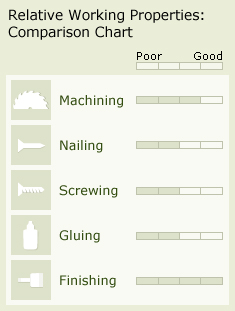
Soft Maple (Acer spp.)

Soft Maple (Acer spp.) is composed of at least 120 species native to North America. The maples can be separated into two groups based on the ray widths of their microscopic anatomy, the soft maple group and the hard maple group. Species within each group look alike microscopically. Acer is the classical Latin name of maple.
Grades Available: Sel/Btr, Paint Grade Sel/Btr, Select, #1 Common, #2 Common
Sizes Available: 4/4, 5/4, 6/4, 8/4
Distribution: Throughout most of North America, with commercial species in the eastern United States and Canada.
The Tree: Maples grow to heights of 120’ ft, with a diameter of 3’ ft. Forest grown trees may have a clear bole of 60’ ft.

General Wood Characteristics: Maple lumber comes principally from the Middle Atlantic and Lake States, which together account for about two-thirds of the production. The wood of silver maple, red maple, and boxelder is known as soft maple. The sapwood of maples is commonly white with a slight reddish-brown tinge; the heartwood is light reddish brown, but sometimes considerably darker. The sapwood is from 3 to 5” + inches thick.
The wood of soft maples resembles that of hard maples but is not as heavy, hard and strong, the better grade of soft maple has been substituted for hard maple in furniture. The sapwood in soft maple is considerably wider than that in the hard maples and has a lighter heartwood color.
Maple lumber sometimes has olive or greenish black discolored areas known as mineral streak or mineral stain, which may be due to injury. Maple wood stains well and takes high polish. It is intermediate in gluing and has low decay resistance.
Working Properties: The wood turns well, is harder to work than softer woods, and has high nail-holding ability. It stains and polishes well, but is intermediate in gluing.
Durability: Rated as slightly or nonresistant to heartwood decay.
Uses: Lumber, distillation, veneer, crossties, paper pulp, flooring, furniture, pallets, boxes and crates, shoe lasts, handles, woodenware, novelties, spools and bobbins, bowling alleys, dance floors, piano frames, bowling pins, cutting blocks, pulpwood and turnery.

